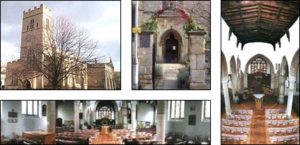 St. George’s stands in its own elegant Georgian square in Stamford. The church is of very early origin and was possibly one of the four churches mentioned, but not named, in the Domesday Book (1086). It was certainly in existence by 1199. As it stands today, its short, narrow, rectangular tower, rebuilt in the 17th century, is barely noticeable above the skyline of the surrounding buildings.
St. George’s stands in its own elegant Georgian square in Stamford. The church is of very early origin and was possibly one of the four churches mentioned, but not named, in the Domesday Book (1086). It was certainly in existence by 1199. As it stands today, its short, narrow, rectangular tower, rebuilt in the 17th century, is barely noticeable above the skyline of the surrounding buildings.
Externally the rest of the church appears to be totally of the 15th century. However, in 1887 transepts and extensions were added as the Victorians transformed its appearance using the same sympathetic design of earlier windows and stonework to careful integrate the additions. Old pews were also removed, a new pulpit was provided and a new floor laid. Like many other churches in Stamford, it has been rebuilt, added to and improved over time, so that it now presents an amalgam of different periods.
There is some mid-13th century work in both the tower and nave, and each has considerably more of the 14th century. In the middle of the 15th century Sir William Bruges, the first Garter King of Arms (who died in 1450) donated a considerable amount of money towards the church. The chancel was extensively rebuilt, new roofs for the whole building were added and a magnificent set of furnishings and windows were provided – much or all of this, apparently, by or at the direction of Bruges. St. George’s was, or claims to be, the original church of the Knights of the Garter. Originally the chancel contained a series of seven windows containing portraits of the King of the Garter, but these were destroyed during the Reformation like most of Bruges’ benefactions to the church. Apart from the roofs of the chancel, nave and aisles, little remains to show his munificence apart from a collection of garter panes in the north chancel window and a few fragments in the south window including the two centre panes of St. Catherine and St. Anne.
Though it is only in imagination that we can appreciate the splendour of St. George’s Church in the middle ages, we hope visitors will find this a place to arouse their interest. One in which they are brought closer to an understanding of what made people spend so much money and time on the building and decoration of the parish churches throughout the country.
Text used by kind permission of St. George’s Church